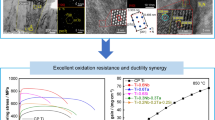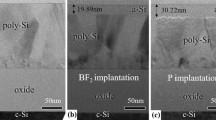Abstract
In our previous studies, thin Ti-rich diffusion barrier layers were found to be formed at the interface between Cu(Ti) films and SiO2/Si substrates after annealing at elevated temperatures. This technique was called self-formation of the diffusion barrier, and is attractive for fabrication of ultralarge-scale integrated (ULSI) interconnects. In the present study, we investigated the applicability of this technique to Cu(Ti) alloy films which were deposited on low dielectric constant (low-k) materials (SiO x C y ), SiCO, and SiCN dielectric layers, which are potential dielectric layers for future ULSI Si devices. The microstructures were analyzed by transmission electron microscopy (TEM) and secondary-ion mass spectrometry (SIMS), and correlated with the electrical properties of the Cu(Ti) films. It was concluded that the Ti-rich interface layers were formed in all the Cu(Ti)/dielectric-layer samples. The primary factor to control the composition of the self-formed Ti-rich interface layers was the C concentration in the dielectric layers rather than the enthalpy of formation of the Ti compounds (TiC, TiSi, and TiN). Crystalline TiC was formed on the dielectric layers with a C concentration higher than 17 at.%.
Similar content being viewed by others
References
S.P. Murarka, Mater. Sci. Eng. Res. 19, 87 (1997). doi:10.1016/S0927-796X(97)00002-8
“The International Technology Roadmap for Semiconductors (ITRS)”, http://www.itrs.net/Links/2003ITRS/Interconnect2003.pdf, 2003
M.T. Bohr, Y.A. El-Mansy, IEEE Trans. Electron Dev.. 45, 620 (1998). doi:10.1109/16.661223
S.P. Murarka, Mater. Sci. Technol. 17, 749 (2001)
Y. Morand, Microelectron. Eng. 50, 391 (2000). doi:10.1016/S0167-9317(99)00307-X
M. Moriyama, M. Shimada, H. Masuda, M. Murakami, Trans. Mater. Res. Soc. Jpn. 29, 51 (2004)
M. Shimada, M. Moriyama, K. Ito, S. Tsukimoto, M. Murakami, J. Vac. Sci. Technol. B 24, 190 (2006). doi:10.1116/1.2151910
P.J. Ding, W.A. Lanford, S. Hymes, S.P. Murarka, J. Appl. Phys. 75, 3627 (1994). doi:10.1063/1.356075
D. Adams, T.L. Alford, N.D. Theodore, S.W. Russell, R.L. Spreitzer, J.W. Mayer, Thin Solid Films 262, 199 (1995). doi:10.1016/0040-6090(94)05805-9
C.J. Liu, J.S. Chen, Appl. Phys. Lett. 80, 2678 (2002). doi:10.1063/1.1468913
C.J. Liu, J.S. Jeng, J.S. Chen, Y.K. Lin, J. Vac. Sci. Technol. B 20, 2361 (2002). doi:10.1116/1.1520552
M.J. Frederick, R. Goswami, G. Ramanath, J. Appl. Phys. 93, 5966 (2003). doi:10.1063/1.1566451
M.J. Frederick, G. Ramanath, J. Appl. Phys. 95, 3202 (2004). doi:10.1063/1.1647264
S. Tsukimoto, T. Morita, M. Moriyama, K. Ito, M. Murakami, J. Electron. Mater. 34, 592 (2005). doi:10.1007/s11664-005-0070-0
S. Tsukimoto, T. Kabe, K. Ito, M. Murakami, J. Electron. Mater. 36, 258 (2007). doi:10.1007/s11664-007-0094-8
K. Ito, S. Tsukimoto, T. Kabe, K. Tada, M. Murakami, J. Electron. Mater. 36, 606 (2007). doi:10.1007/s11664-007-0097-5
J. Perez-Rigueiro, P. Herrero, C. Jimenez, R. Perez-Casero, and J.M. Martinez-Duart, Surf. Interface Anal. 25, 896 (1997). doi:10.1002/(SICI)1096-9918(199710)25:11<896::AID-SIA315> 3.0.CO;2-4
The Japan Institute of Metals ed., Metal Databook, 4th ed. (in Japanese) (Tokyo: Maruzen Co., Ltd., 2004), pp. 101
D.G. Archer, R.J. Kematick, C.E. Myers, S. Agarwal, E.J. Cotts, J. Chem. Eng. Data 44, 167 (1999). doi:10.1021/je9802120
Acknowledgements
This work was supported by Grants-in-Aid for Scientific Research from The Ministry of Education, Culture, Sports, Science, and Technology (18360324). The authors would like to thank the Shorai Foundation for Science and Technology, and the Iketani Science and Technology Foundation for financial support.
Author information
Authors and Affiliations
Corresponding author
Rights and permissions
About this article
Cite this article
Kohama, K., Ito, K., Tsukimoto, S. et al. Characterization of Self-Formed Ti-Rich Interface Layers in Cu(Ti)/Low-k Samples. J. Electron. Mater. 37, 1148–1157 (2008). https://doi.org/10.1007/s11664-008-0482-8
Received:
Accepted:
Published:
Issue Date:
DOI: https://doi.org/10.1007/s11664-008-0482-8




